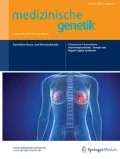Zusammenfassung
Defekte der Steroidhormonsynthese können mit einem Mangel oder Überschuss an Androgenen einhergehen, die zu Störungen der Geschlechtsentwicklung und im weiblichen Geschlecht zur Ovarialinsuffizienz führen.
Abstract
Defects of steroid hormone biosynthesis can be associated with deficient or increased concentrations of androgens leading to disorders of sexual development or ovarian dysfunction.

Literatur
Lin D, Sugawara T, Strauss JF et al (1995) Role os steroidogenic acute regulatory protein in adrenal and gonadal steroidogenesis. Science 267:1828–1831
Rheaume E, Simard J, Morel Y et al (1992) Congenital adrenal hyperplasia due to point mutations in the type II 3β-hydroxystroid dehydrogenase gene. Nat Genet 1:239–245
Pang S, Lerner AJ, Stoner E et al (1985) Late-onset adrenal steroid 3β-hydroxysteroid dehydrogenase deficiency. A cause of hirsutism in pubertal and postpubertal women. J Clin Endocrinol Metab 60:428–439
Chung BC, Picado-Leonard J, Haniu M et al (1987) Cytochrome P450C17 (steroid 17 hydroxylase/17,20-lyase): cloning of human adrenal and testis cDNAs indicate the same gene is expressed in both tissues. Proc Natl Acad Sci 84:407–411
Geissler WMD, Davis DL, Wu L et al (1994) Male pseudohermaphroditism caused by mutations of testicular 17β-hydroxysteroid dehydrogenase 3. Nat Genet 7:34–39
Thipgen AE, Davis DL, Milatovich A et al (1992) Molecular genetics of 5α-reductase 2 deficiency. J Clin Invest 90:799–809
Evans CT, Ledesma DB, Schulz TZ et al (1986) Isolation and characterization of a complementary DNA specific for human aromatase-system cytochrome P450mRNA. Proc Natl Acad Sci 83:6387–6391
White PC, Speiser PW (2000). Congenital adrenal hyperplasia due to 21-hydroxylase deficiency. Endocr Rev 21:245–291
Clayton PE, Miller WL, Oberfield SE et al (2002). Consensus statement on 21-hydroxylase deficiency from the Lawson Wilkens Pediatric Endocrine Society and the European Society For Pediatric Endocrinology. J Clin Endocrinol Metab 87:4048–4053
Blanché H, Vexiau P, Clauin S et al (1997) Exhaustive screening of the 21-hydroxylase gene in a population of hyperandrogenic women. Hum Mut 101:56–60
New MI (2006) Nonclassical 21-hydroxylase deficiency. Clin Endocrinol Metab 91:4205–4214
Ezquieta B, Beneyto M, Muñoz-Pacheco R et al (2006) Gene duplications in 21-hydroxylase deficiency: the importance of accurate molecular diagnosis in carrier detection and prenatal diagnosis. Prenat Diagn 26:1172–1178
Chua S, Szabo P, Vitek A et al (1987) Cloning of cDNA encoding 11β-hydroxylase (P450C11). Proc Natl Acad Sci 84:7193–7197
Wassif CA, Maslen C, Kachilele-Linjewile et al (1998) Mutations in the human sterol delta-7 reductase gene in 11q12–13 cause Smith-Lemli-Opitz syndrome. Am J Hum Genet 63:55–62
Fluck CE, Tajima T, Pandey AV, Arlt W (2004) Mutant P450 oxidoreductase causes disordered steroidogenesis with and without Antley-Bixler syndrome. Nat Genet 36:228–230
Kahsar-Miller MD, Nixon C, Boots LR et al (2001) Prevalence of polycystic ovary syndrome (PCOS) in first-degree relatives of patients with PCOS. Fertil Steril 75:53–58
Moller DE, Cohen O, Yamaguchi Y et al (1994) Prevalence of mutations in the insulin receptor gene in subjects with features of the type A syndrome of insulin resistance. Diabetes 43:247–255
Kadowaki T, Kadowaki H, Accili D, Taylor SI (1990) Substitution of lysine for asparagines at position in the alpha-subunit of the human insulin receptor: a mutation that impairs transport of receptors in the cell surface and decreases the affinity of insulin binding. J Biol Chem 265:19143–19150
OMIM, http://www.ncbi.nlm.nih.gov/omim/
Urbanek M (2007) The genetics of the polycystic ovary syndrome. Nat Clin Pract Endocrinol Metab 3:103–111
Interessenkonflikt
Die Autoren geben an, dass kein Interessenkonflikt besteht.
Author information
Authors and Affiliations
Corresponding author
Rights and permissions
About this article
Cite this article
Wieacker, P., Preisler-Adams, S. Störungen der Bildung von Sexualsteroidhormonen und Hyperandrogenämie bei der Frau. medgen 23, 244–248 (2011). https://doi.org/10.1007/s11825-011-0276-x
Published:
Issue Date:
DOI: https://doi.org/10.1007/s11825-011-0276-x

